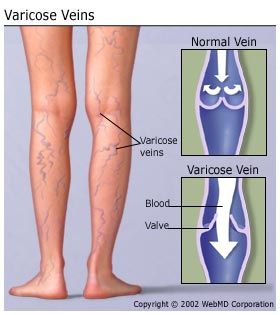Varicose veins are gnarled, enlarged veins. Any vein may become varicose, but the veins most commonly affected are those in your legs and feet. That's because standing and walking upright increases the pressure in the veins of your lower body.
For many people, varicose veins and spider veins — a common, mild variation of varicose veins — are simply a cosmetic concern. For other people, varicose veins can cause aching pain and discomfort. Sometimes varicose veins lead to more-serious problems.
Varicose veins may also signal a higher risk of other circulatory problems. Treatment may involve self-care measures or procedures by your doctor to close or remove veins.
Symptoms
Varicose veins may not cause any pain. Signs you may have with varicose veins include:
* Veins that are dark purple or blue in color
* Veins that appear twisted and bulging; often like cords on your legs
* An achy or heavy feeling in your legs
* Burning, throbbing, muscle cramping and swelling in your lower legs
* Worsened pain after sitting or standing for a long time
* Itching around one or more of your veins
* Bleeding from varicose veins
* A painful cord in the vein with red discoloration of the skin
* Color changes, hardening of the vein, inflammation of the skin or skin ulcers near your ankle, which can mean you have a serious form of vascular disease that requires medical attention
Spider veins are similar to varicose veins, but they're smaller. Spider veins are found closer to the skin's surface and are often red or blue.
They occur on the legs, but can also be found on the face. Spider veins vary in size and often look like a spider's web.

No comments:
Post a Comment